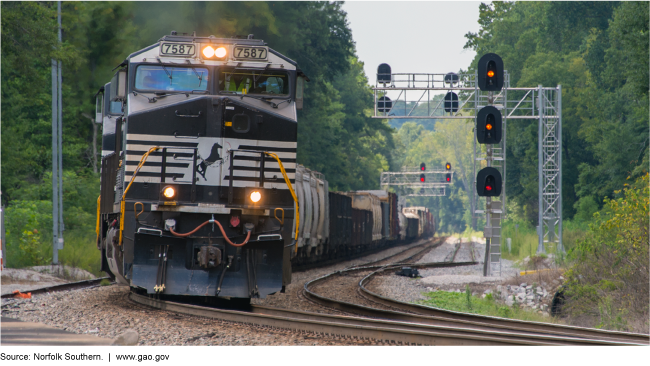Positive Train Control: Railroads Generally Made Progress, but Several Must Meet Compressed Schedules to Meet Implementation Date
Fast Facts
Positive train control (PTC) is a communications-based system designed to automatically slow or stop a train that isn’t being operated safely. 42 railroads—including Amtrak, 30 commuter railroads, and several freight railroads—were required to implement PTC by December 31, 2018. Almost all received 2-year extensions.
Most railroads were in the final testing and implementation stages of PTC at the end of 2019. However, several face tight schedules for the rest of the work, making problems with software and vendors more acute. Nonetheless, railroads are generally optimistic about finishing required work by the end of 2020.

train
Highlights
What GAO Found
Positive Train Control (PTC) is a communications-based system designed to automatically slow or stop a train that is not being operated safely. By December 31, 2019, more than three-quarters of the 42 railroads required to implement PTC were conducting advanced testing, or had implemented PTC on their own track segments, but had work left to reach full implementation. Full implementation means a railroad has implemented a Federal Railroad Administration (FRA)-certified PTC system on all its own required territories and achieved interoperability with any railroads that operate on its tracks. Just under half of the 42 railroads reported making progress between March 31, 2019 and December 31, 2019, but no additional railroads reached full implementation. However, railroads generally reported progress on achieving interoperability, which is a critical step in order for U.S. railroads to share tracks. From March 31, 2019, to December 31, 2019, six additional railroads reported achieving interoperability with at least one other railroad, resulting in 17 of the 31 railroads that must achieve interoperability having done so.
Railroads’ Positive Train Control (PTC) Implementation Status as of December 31, 2019

Note: Full implementation means a railroad has implemented a Federal Railroad Administration-certified PTC system on all its own required territories and has achieved interoperability with any railroads that operate on its tracks. The four railroads that have reached full PTC implementation did so by the December 31, 2018 deadline.
While some railroads reported making progress on specific challenges GAO has previously identified, longstanding software and vendor issues have grown more acute as many railroads face compressed schedules to implement PTC by December 31, 2020. For example, five selected railroads have had to compress their schedules, meaning they must complete tasks in a shorter time than originally planned, due to software issues or other unique circumstances. The compressed schedules and recurring challenges, as well as unexpected events such as the COVID-19 global pandemic, create risks that could affect some railroads' ability to meet the extended deadline.
FRA, vendors, and railroads have taken several steps to mitigate such risks. For example, FRA has worked with railroads to identify solutions to technical problems and has targeted its resources to regions it identified as needing additional implementation assistance. Additionally, FRA officials told us they are closely monitoring the effects of the COVID-19 global pandemic, such as the availability of supplies, staff, and vendors. In light of these efforts, FRA, vendors, and railroads were generally optimistic that they will overcome challenges to achieve full PTC implementation by December 31, 2020, though four railroads reported considering contingency plans if they, or their tenants, cannot meet the extended deadline. Nonetheless, completing implementation requirements by the end of 2020 will be but a first step for full PTC operations, as railroads and others said that some additional PTC work will likely continue beyond the end of 2020.
Why GAO Did This Study
Forty-two railroads—including 30 commuter railroads, Amtrak, and several freight railroads—are currently subject to the statutory mandate to implement PTC. Railroads were required to implement PTC by December 31, 2018, but almost all received extensions up to December 31, 2020, by meeting specific statutory requirements.
GAO was asked to review railroads' PTC implementation progress. This report discusses (1) railroads' implementation progress between March 31, 2019 and December 31, 2019, and (2) selected railroads' challenges implementing PTC by December 31, 2020, and steps they and FRA have taken to mitigate these challenges.
GAO analyzed all railroads' most recent quarterly reports submitted to FRA, which reflected progress as of December 31, 2019. GAO also interviewed officials from 12 railroads, selected in part to include the eight railroads FRA identified in February 2020 as "at-risk" of not completing PTC implementation by the extended deadline. In addition, GAO interviewed officials from FRA, commuter and freight railroad industry associations, and three vendors that provide PTC products or services.
For more information, contact Elizabeth Repko at 202-512-2834 or RepkoE@gao.gov.
